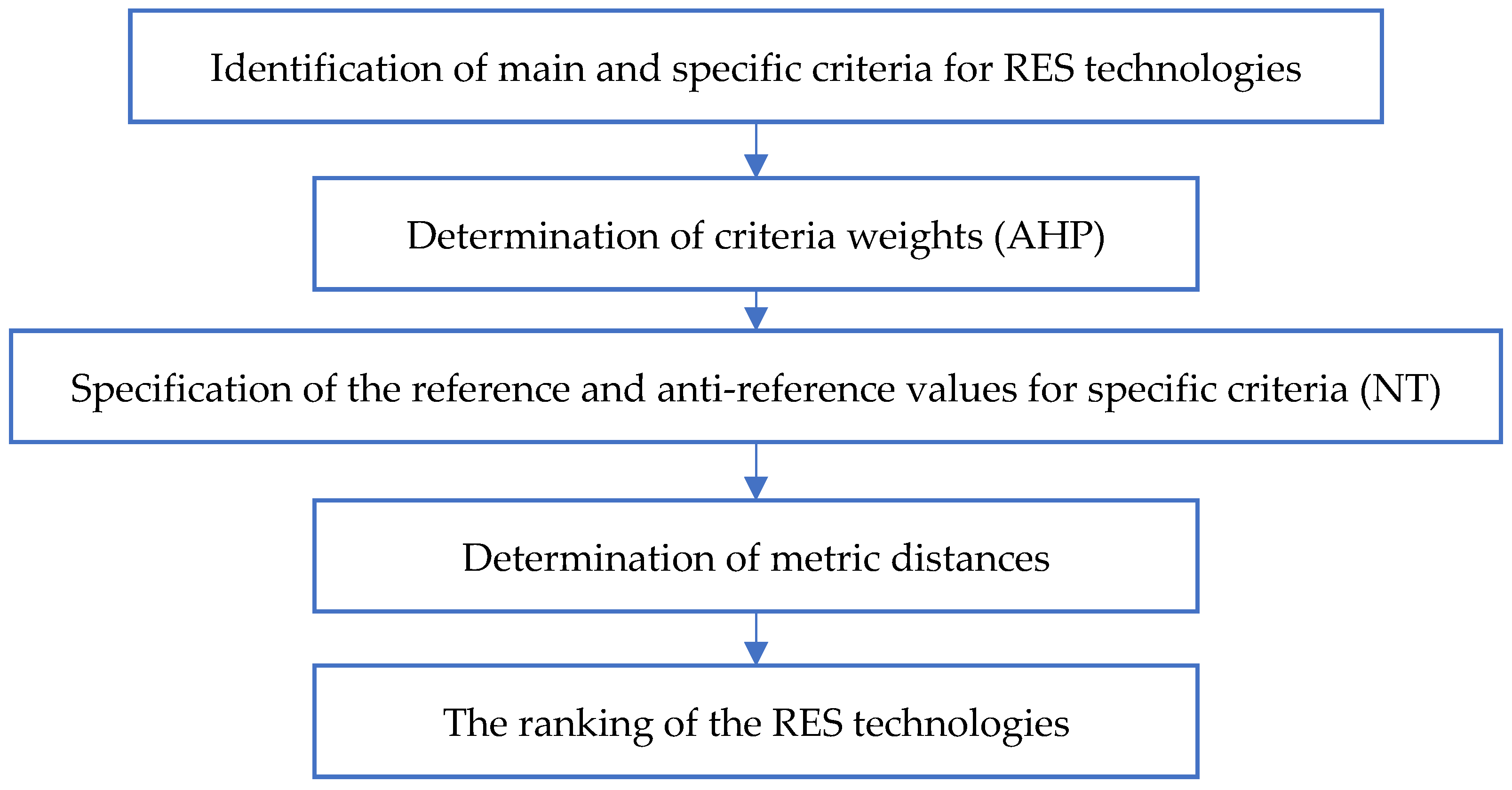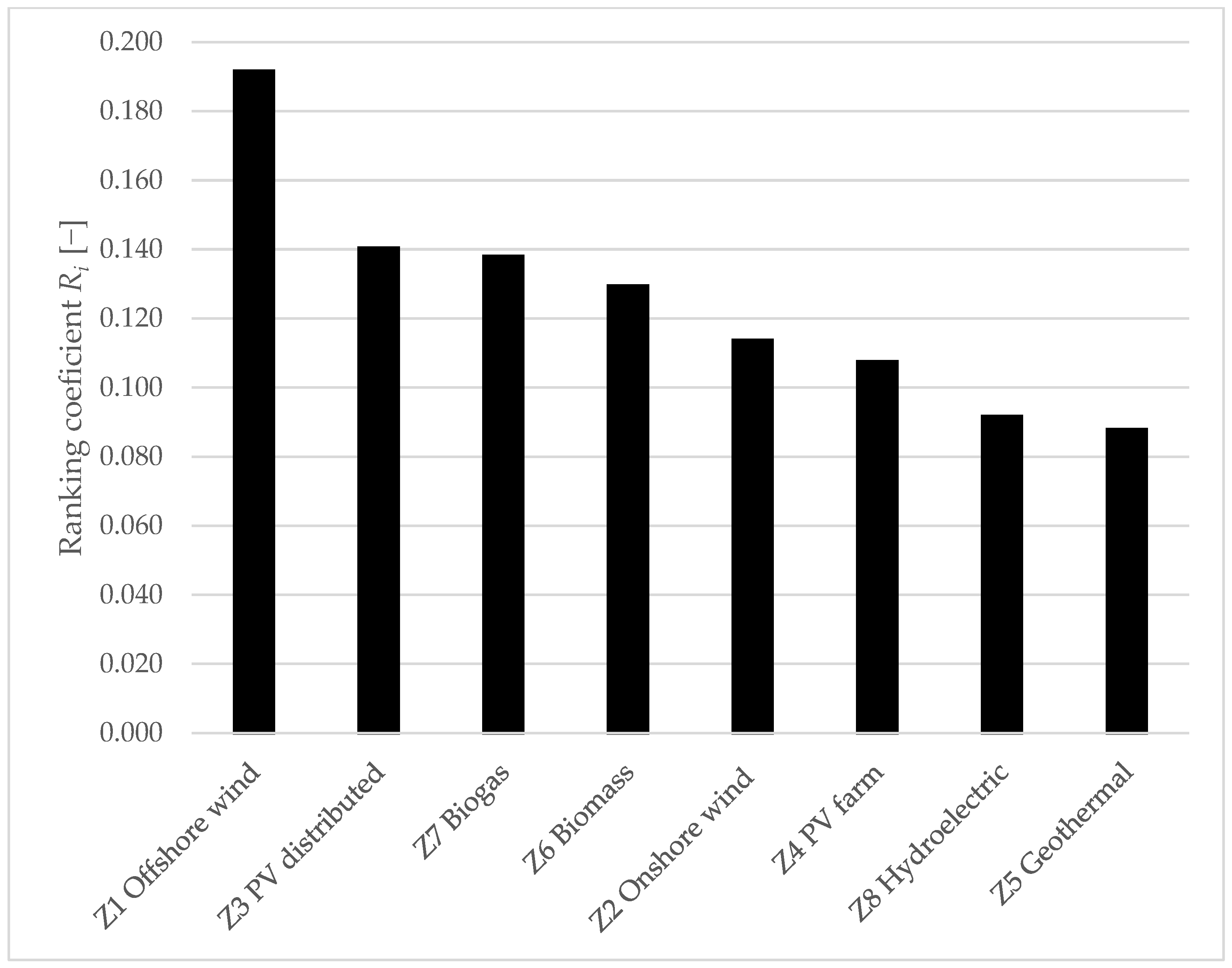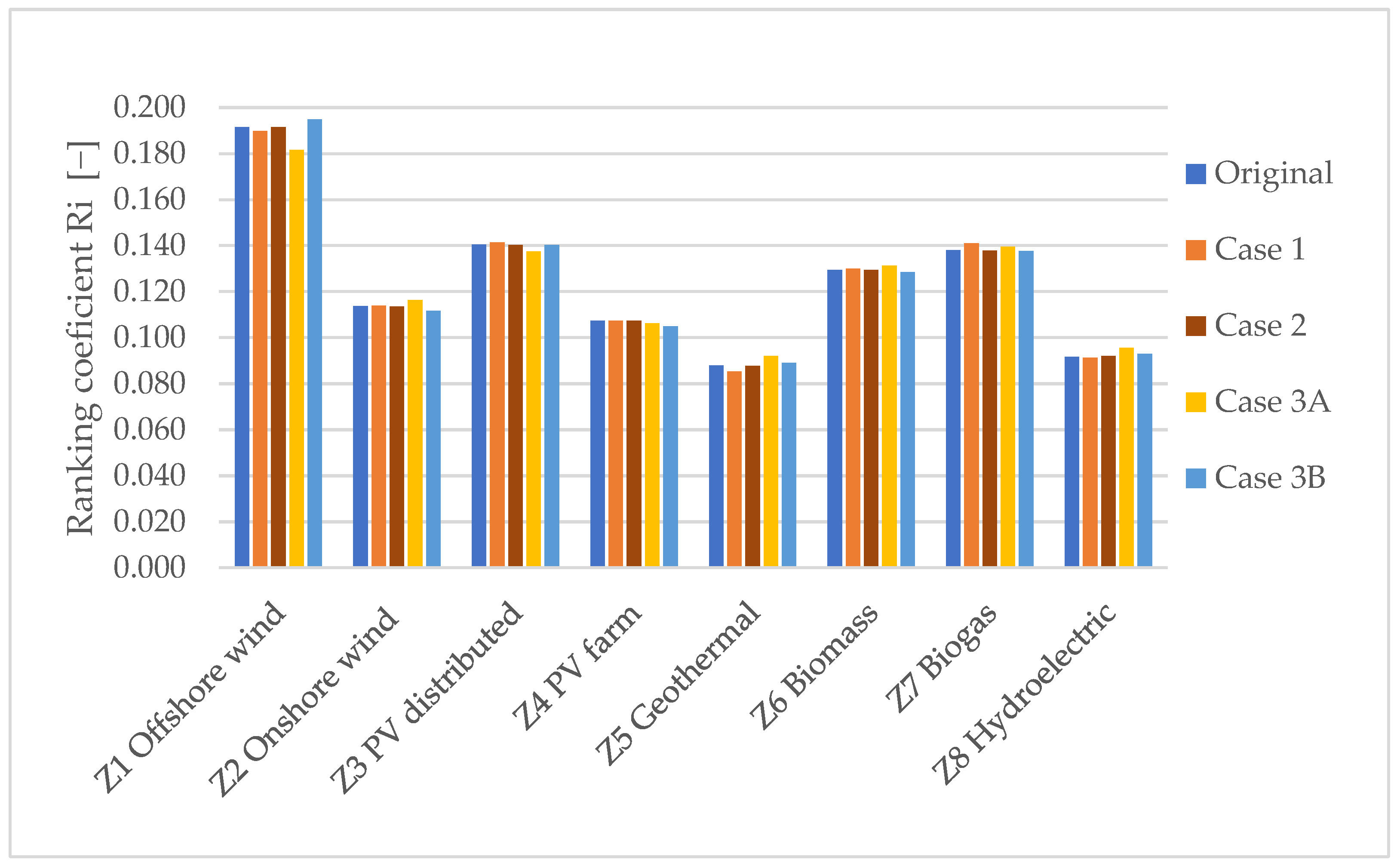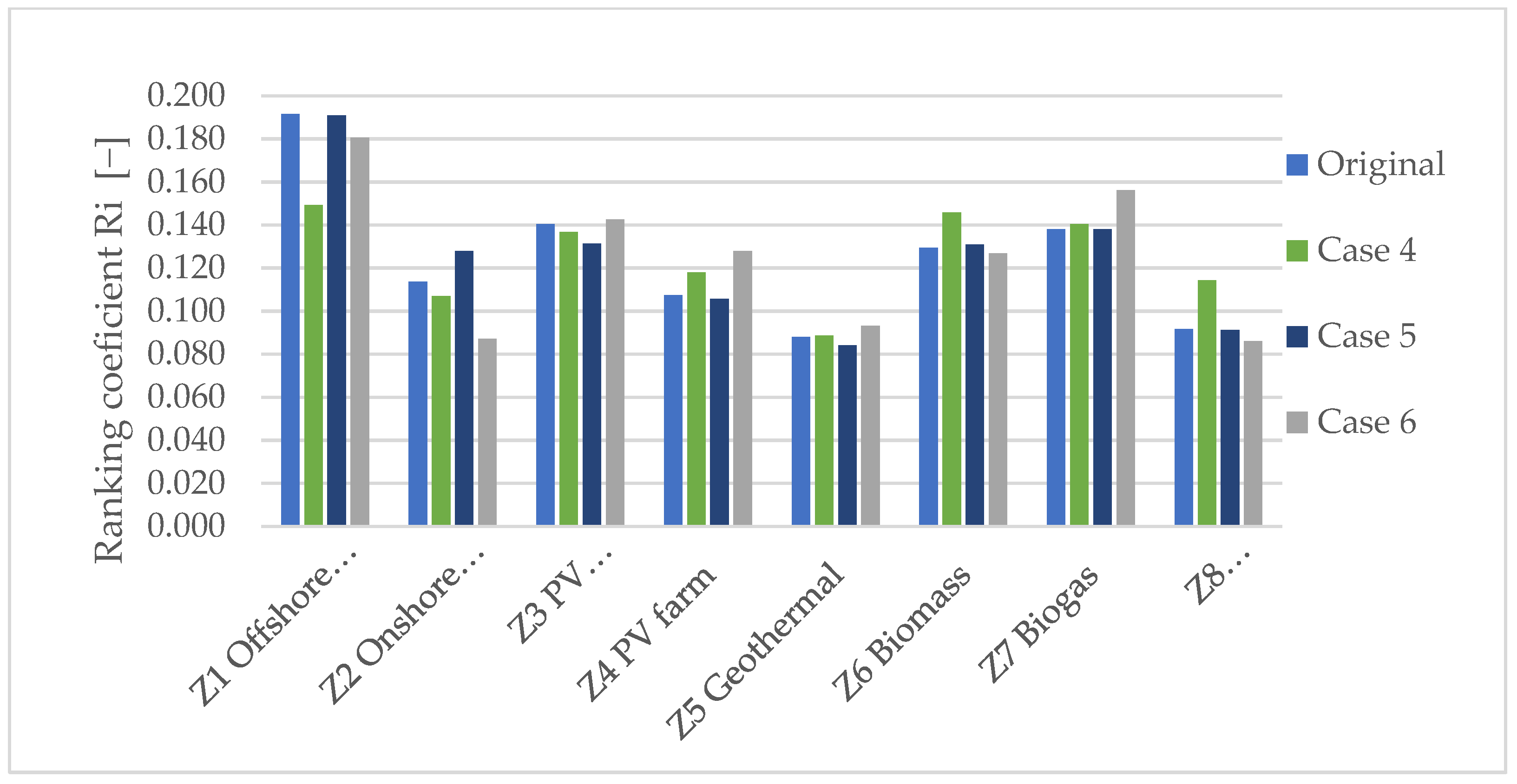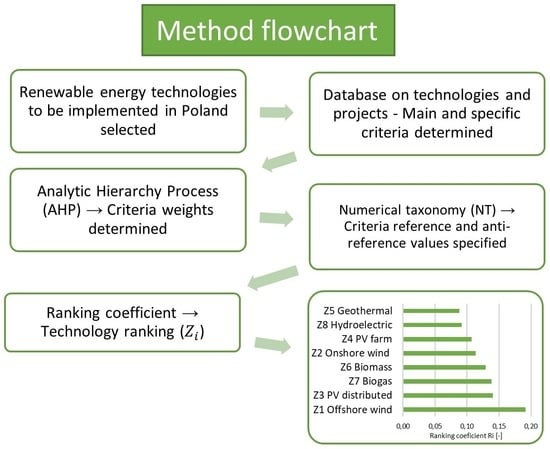The article answers the question of which RES-based technology is the best for installation in Poland. For this purpose, a ranking of electricity generation technologies based on the use of renewable energy sources in Poland was developed. Using a combination of AHP methods and numerical taxonomy to obtain such a ranking has never been a subject of prior published research, to the author’s best knowledge.
2.2. Identification of Main and Specific Criteria
Selection criteria optimization and their quantities are crucial for the correctness of this analysis. The number of criteria depends on the amount of data [
38]. The most common criteria for evaluating RES technologies include environmental, technical, economic, and social issues [
39,
40,
41,
42].
There are five groups of main criteria
: technical
, economic
, social
, environmental
, political and legal
. Within each main criterion, detailed criteria
were developed, which are presented in
Table 1.
Scales for assessing individual detailed criteria have been introduced, depending on their nature and type of RES technology. Standardization of criteria rating scales has been applied, which may be expressed as numbers, percentages, or any other manner convenient for the user. The scales used for assessing specific criteria are presented below.
Technical criteria
In the group of technical criteria, nine detailed criteria were used. The set of specific criteria is the most numerous of all the main criteria. In the literature, the technical criteria are included in the studies [
43,
44,
45]. For the purposes of this analysis, sub-criteria have also been specified.
The first sub-criterion in this group —availability of primary raw materials—was assessed based on an analysis of technically useful primary energy resources in Poland that can be used in electricity production. The scale values of this criterion are treated as stimulants.
The sub-criterion —time of installed capacity utilization—is expressed in [h/year]. The criterion expresses the capacity of a given technology to produce energy, typical in Polish conditions, resulting from the variability of the availability of primary energy resources. The values were adopted based on the average productivity of the already existing facilities, and for new technologies, based on the analysis of the average long-term meteorological measurements and the features of a given technology. The criterion is a stimulant. The significance of this criterion is important not only because it allows us to estimate the future energy production from each unit of installed capacity, but also indirectly expresses the need to balance the source’s production and the need to maintain reserve capacity in the power system.
The sub-criterion reflects the typical power ranges of individual sources of a given technology. There are four classes used in this criterion: micro, small, medium, and large energy sources. The criterion indirectly describes the role of the sources in the system. It acts as a stimulant in the technology assessment method.
The sub-criterion is a criterion describing the distance of the location of energy resources in relation to the existing power grids. Average distances of resources from the grid were estimated based on maps showing the location of resources and the topography of power grids. The distances are expressed in kilometers. This sub-criterion is regarded as a destimulant.
The sub-criteria i characterize the typical voltage level of the network to which the sources are connected and the potential impact of a given energy technology on slow and dynamic voltage fluctuations in the network. For the voltage level criterion, four classes were used, resulting from the role of grids with different voltage levels in the Polish power system.
The sub-criterion acts as a stimulant. It is characterized by typical for each technology’s short- and medium-term predictability of production. In the conditions of the energy market, the significance of this criterion is important not only for technical reasons caused in the power system by high variability and low predictability of the level of energy production by the source but also because of the economic consequences of this type of work. In the case of the sub-criterion, classes were adopted that characterize the need to expand or adapt the existing power grid to the needs of a given technology. This sub-criterion influences the evaluation of the technology as a destimulant.
The sub-criterion for the efficiency of the RES technology is a stimulus and favors technologies that make better use of local renewable energy resources.
Economic criteria
Five sub-criteria were prepared to allow the assessment of the national conditions for the development of the analyzed technologies. For each generation source, a financial analysis was carried out, which took into account the financial flows related to construction and operation. It includes financial support for individual technologies, such as guaranteed prices of energy under the RES auction, reference prices of energy from RES [
46], and available subsidies. Financial calculations were the basis for determining the payback period (SPBT) [
47] and the economic IRR indicator.
The first two sub-criteria
and
are expressed in [EUR/kW] and characterize the average unit investment outlays, respectively, for generation systems and their connection to the power grids. The investment outlays were assessed for every energy technology based on available literature data [
48,
49,
50,
51] and information on investment processes implemented in Poland [
7,
52]. Both sub-criteria are regarded as destimulants.
The sub-criterion —payback period (SPBT)—is expressed in years. The sub-criterion is defined as a simple payback period for incurred inputs. It is, in the authors’ opinion, the easiest indicator of the profitability of the investment, allowing the comparison of technology and based on generally accepted and universal methods of its calculation. The analyses carried out for this article were based on current (2019 and 2020) Polish data.
The sub-criterion is the average IRR for typical projects in the analyzed technologies, expressed in percentages. IRR was introduced into the analysis as a commonly used dynamic indicator of investment profitability of projects, acting as a stimulant.
The sub-criterion is expressed in [Euro/MWh] and describes the technology demand for capacity maintenance and servicing activities. The sub-criterion is a destimulant in the performed analysis.
Social criteria
In the group of social criteria, three sub-criteria were proposed, all of which are stimulants in the analysis performed. Due to the difficulties with fully objective assessment, it was assumed that the detailed sub-criteria
—public support for investment—and
—favor of local authorities for investment—are assessed with a numerical scale in the range 1–5, which has no linguistic equivalent. The appropriate value in the scope was selected using an expert method based on examples of the implementation of investment projects related to renewable energy sources in Poland [
53,
54], implemented and planned in the recent period. For sub-criterion
—investment compliance with local policies—a numerical scale was used, corresponding to the linguistic assessment of the criterion (
Table 2). The assessment was made with an expert method based on existing spatial planning documents functioning in Polish practice. Plans for a few typical areas with significant renewable energy resources were analyzed.
Environmental criteria
Seven environmental sub-criteria have been defined. The sub-criterion
is the factor of avoided CO
2 emissions expressed in [Mg CO
2/year] [
55]. It is treated as a stimulant.
The sub-criteria
and
are accepted as destimulants; therefore, the desired values are the minimum values. The sub-criterion
is characterized by the average level of noise emitted by a given energy source and is expressed in decibels [
13,
56,
57]. For sub-criterion
—impact on animal population—the percentage rating scale is shown in
Table 3.
The sub-criterion denoting the impact of the investment on the landscape was determined with a percentage scale ranging from 0 to 100%. The assessment was made using the expert method while realizing that the assessment of this criterion was highly subjective. In this case, no formalized evaluation scale was used, due to the difficulties in creating universal methods of assessing very diverse technologies located in different areas of very different environmental and aesthetic value.
The sub-criteria and are expressed in kilometers, and both are destimulants. They express the average distance of typical locations in Poland from protected areas and human settlements, respectively.
The sub-criterion, describing the average occupied area by systems of assessed technologies in [km2/MW], is also a destimulant in the analysis.
Political and legal criteria
The group of political and legal criteria includes six sub-criteria
, for which it is proposed to adopt a rating scale in the form of classes (quantified) expressing the availability of given system support for a given technology and possibly the strength of this support and its diversity. All sub-criteria in this group are stimulants. Analyzing the national legal acts [
58], an expert assessment of the intensity of support for individual technologies and the existing restrictions hampering their location and use was made. For the sub-criteria
a binary score (0 or 1) was adopted, expressing only the availability of a specific support system for the analyzed technology.
2.3. RES Identification in Relation to Optimization Criteria
After determining the set of optimization criteria, the alternatives should be identified. This article describes technologies that can be developed in Poland in the context of energy policy until 2040 [
12]; the following technologies have been distinguished:
Z1—Offshore wind farms;
Z2—Onshore wind farms;
Z3—Distributed photovoltaic power plants;
Z4—Solar farms;
Z5—Geothermal power plants;
Z6—Biomass-fired power plants;
Z7—Biogas plants;
Z8—Hydroelectric power stations.
Each technology is described based on a set of optimization criteria described in
Section 2.2. as shown in
Table 4. The data sources of this study are based on authors’ calculations and an analysis of the literature [
7,
13,
43,
44,
45,
46,
47,
48,
49,
50,
51,
52,
53,
54,
55,
56,
57,
58].
In order to compare technologies, data representative for each analyzed case was selected. For the technical criteria, the data have been averaged and approximated, with the exception of the X19 criterion, i.e., the efficiency of the technology. For the X1.2 criterion, the number of hours was determined on the basis of the installed capacity utilization factor appropriate for each technology [
59]. The values of the economic criteria were determined by economic analysis for each technology using the Free Cash Flow to Firm (FCFF) method for the analyzed period of 25 years of an installation operation. For the Z1 technology, investment outlays were averaged and determined based on the data included in [
60]. Data adopted for the analysis for other sources: Z2—the unit outlays were based on [
61]; Z3—capital expenditures for distributed photovoltaic power plants with a capacity of 5 kW amount to approx. PLN 31,000 (1305 EUR/kW) [
62]; Z4—investment outlays are in the range of PLN 2.5–3.6 million/MW (530–760 EUR/kW) [
59,
63]. According to data from IRENA Renewable Cost Database [
59], the cost of geothermal installations (Z5) is in the range of 2000–6000 EUR/kW. Due to the lack of technology in Poland, it was decided to assume a value higher than the average for the calculations. Capital expenditures on biomass-related technologies (Z6) were determined based on the data presented in [
64]. A biogas power plant (Z7) in Poland requires investment outlays of PLN 12 million/MW (2500 EUR/kW) [
59,
65]. The range of investment outlays for hydropower plants (Z8) is 600–4500 EUR/kW and depends on the size of the installation. In Polish conditions, a value below the average was assumed, which is justified from the point of view of accessibility and the typical drop height of watercourses.
This paper separates the financial outlay for the construction of an electricity generation source and the construction of a connection from the source to the power system. Constructing a connection for generation sources located on land requires laying a power line and building a power supply point. Expenditures for the construction of power line connections from offshore wind farms range from 600–1200 EUR/kW [
66]. Due to the poorly developed power system in the north of Poland, a value above the average was assumed for the analysis. Values in the range of 300–400 EUR/kW were assumed for RES sources located on land [
67]. The exception is the Z3 technology due to its location, where access to the power system is ensured due to living conditions. For the economic criterion X25, which means the operating costs for the installation, Z1 and Z2 sources were determined on the basis of the data presented in [
60,
61], and for the remaining installations on the basis of the data contained in [
62,
64,
66,
67].

